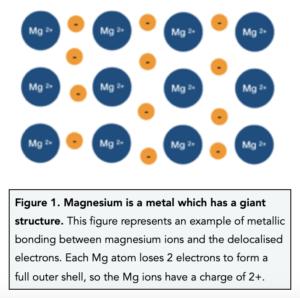Metallic Bonds (GCSE Chemistry)
Metallic Bonds
Metallic Bonding
- Metals have a ‘sea’ of delocalised electrons. Most metals are located in groups 1-3 of the periodic table meaning they have either 1, 2 or 3 electrons in their outermost shell. Each metal atom loses these electrons to gain a full outer shell of electrons and become positively charged ions. The electrons become delocalised into a ‘sea’ of negative charge.
- Delocalised electrons are free to move around. The delocalised electrons in metallic structures are not associated with a single ion, Instead, they are free to move throughout the whole metallic structure.
- Electrostatic attractions keep the metal together. A metallic bond is the strong electrostatic attraction between sea of negative delocalised electrons and positive metal ions.
- 3-D metallic lattice is formed in metallic bonding. A metal consists of lots of positive metal ions packed closed together in a regular arrangement and their delocalised electrons. The electrostatic attraction between the positive and negative charges, act in all directions, causing the ions to form a giant 3-D metallic lattice.






Still got a question? Leave a comment
Leave a comment